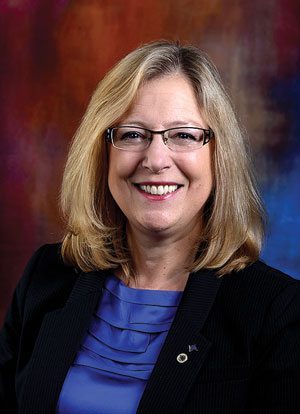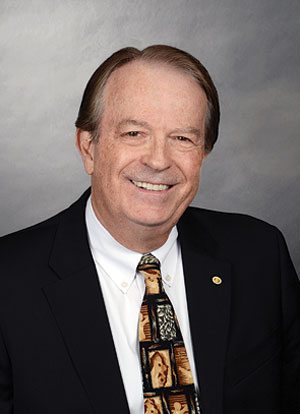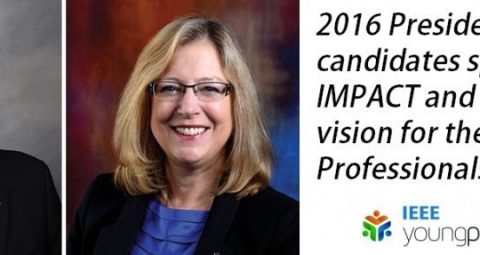Today we bring you an IEEE IMPACT exclusive interview with the 2016 IEEE President Elect candidates.
The IEEE Board of Directors has nominated Senior Member Karen Bartleson and Life Fellow Frederick “Fred” Mintzer as candidates for 2016 IEEE president-elect. They are set to face off in the annual election later this year. The winner will serve as IEEE president in 2017.
Karen Bartleson (www.KarenBartleson.net)

Karen Bartleson is a Senior Director at Synopsys, an electronic design automation company.
“Karen Bartleson is a Senior Director at Synopsys, an electronic design automation company. Her responsibilities include technical standards development, software tool interoperability, relationships with universities and research institutions worldwide, and customer engagement through social media. Karen was 2013-2014 President of the IEEE Standards Association. As President, she led their new strategic plan, furthered the OpenStand™ market-driven standardization paradigm, and finalized IEEE’s membership in the Global Standards Collaboration. She chaired the IEEE Internet Initiative, whose charter is to raise IEEE’s influence in Internet governance, cyber-security, and cyber-privacy policy. She was also a member of IEEE’s strategy committee, overseeing the role of IEEE in global public policy. She received the 2003 Marie R. Pistilli Women in Electronic Design Automation Achievement Award and authored The Ten Commandments for Effective Standards: Practical Insights for Creating Technical Standards. She holds a BS in engineering science with an electronic engineering concentration from California Polytechnic State University.”
What prompted you to become an IEEE member and volunteer?
I became an IEEE member the same way many of you did. While I was in engineering school, one of my professors encouraged me to join. He told me that it was important to be part of a professional organization, and it could help my career. Like you, I remained a member after I went to work. My in-depth volunteering began when I became involved in technical standards development. It was a perfect blend of volunteering for the IEEE Standards Association and doing my job for my employers. I have been asked how members can balance volunteering and their “day job”. I suggest finding activities in the IEEE that complement your work. That is a secret to success.
If elected, how do you see yourself positively affecting IEEE Young Professionals?
I see positive effects in both directions. You should know that you, as IEEE’s Young Professionals, truly inspire me. Your enthusiasm for technology and your passion to make the world a better place give me much optimism for the future. The way you connect with and support each other is something I want to do on a daily basis, and I can learn a lot from you. In return, I would like to offer you my experience of three decades as an engineer. I would like to be a role model for what you can achieve in your careers and your lives. I want to get you more involved in the leadership and governance of the IEEE. And I want to make IEEE so valuable to you that someday you call yourselves Life Members.
Outside of your professional work, what are your hobbies and interests?
My favorite thing to do at the end of the day is to cook a fancy dinner. I enjoy international cuisines and make dishes from recipes in my cookbooks and ones I find online. Once I made an Ethiopian feast, complete with injera. I prepared “safari steak for the hunter” from my African cookbook. I like to make Thai, Indian, Mediterranean, and other kinds of food from all over the world. I have yet to produce a Brazilian barbeque, but that is on my list. Before I became so busy with work and the IEEE, I loved to go camping and fly fishing. Maybe in a few years, I will have time to do these again. Having a garden and backyard chickens, like I had when I was in college, is a future goal of mine.
What advice can you offer to IEEE Young Professionals?
Please, Young Professionals, never lose your bright spirit or your sense of confidence. You will likely face challenges both at work and at home. During those times, remember that you are not alone. Connect with your colleagues, your friends, your family, and your mentors for the support that will help you overcome difficulties. Be sure to take time to celebrate your successes. If you look back at the end of each year and recall all your great accomplishments, you will be enthusiastic about the year to come. Do not be afraid to try new things. Ask yourself this question that my mother taught me to ask when you face a tough decision, “What is the worst thing that could happen?” Often, the worst thing is something not so terrible, and it is well worth the risk to take on a new, exciting adventure. Finally, keep learning – not only technically, but also socially. The world will continue to change, and if you embrace it, you will be amazed.
Frederick “Fred” Mintzer (www.FredMintzer.net)

Fred Mintzer was the program director for IBM’s Blue Gene Watson supercomputer facility and associate director of its Deep Computing Institute, both at the company’s T.J. Watson Research Center, in Yorktown Heights, N.Y from 2005 to 2013. He retired on 1 January 2014.
“Fred Mintzer received a BSEE from Rutgers University and a PhD in EECS from Princeton University. He joined IBM’s Thomas J. Watson Research Center in 1978. Beginning in the middle 1980s, he managed a team that developed new technologies for image database applications and validated them in projects with cultural institutions that included the Vatican Library, Russia’s Hermitage Museum, and the Egyptian Museum in Cairo. From 2001 until 2005, he managed the Visual Technologies Department which developed new technologies for digital imaging, computer graphics and data visualization. From 2005 until retirement in 2013, he was the Program Director for IBM’s Blue Gene Watson facility, which once included the world’s second fastest supercomputer. He produced over fifty publications, twenty-five patents, and key features of several IBM offerings. His honors include recognition as an IEEE Fellow, membership in the IBM Academy of Technology and twice being named an IBM Research Master Inventor.”
What prompted you to become an IEEE member and volunteer?
My first professional job was with a small operating telephone company in northeastern Pennsylvania. While it generously provided me with continuing education in telephony, there were only a few professional colleagues in the workplace – and no real technical community. Near that work location, there were few electrical engineers – and no IEEE activities. After a few years there, I felt something was lacking. I decided to move on and advance technically. I resigned that position and entered graduate school at Princeton.
At Princeton, there was a lively community of graduate students who read papers, mostly IEEE papers, and talked tech. It was a great experience. As I advanced through graduate school, I had the opportunity to attend IEEE conferences and network with some of the pioneers of my field – signal processing. Another great experience.
Interacting with Princeton professors and IEEE conference attendees taught me much about being a professional. It includes being part of a professional community; learning from the community; observing standards of the community; and contributing to the community. This is something I desired to be. I recognized that becoming an IEEE member could greatly help me to become a professional. That is why I became an IEEE member.
After graduate school, I joined IBM’s TJ Watson Research Center in Yorktown Heights, NY. There, I found an active signal processing community that was in many ways connected to the IEEE. One of my IBM colleagues, Harvey Silverman, told me there was an opening on an IEEE technical committee (Digital Signal Processing) – and asked whether I would I like to join. I did – and I was soon able to network more broadly, discuss the state of the art of my field, and contribute to the IEEE signal processing community. This was very satisfying. So … you might say I became an IEEE volunteer because of a fortuitous invitation, found it very satisfying, and have continued to be one. Like many other IEEE volunteers, I am indebted to the colleague who gave me that first opportunity to volunteer.
If elected, how do you see yourself positively affecting IEEE Young Professionals?
I believe today’s young professionals differ from more senior IEEE members in some significant ways. They communicate differently – having grown up with the Internet, smart phones and social media. They live in a more dynamic work environment – where they will change jobs more frequently. And they have a stronger interest in social responsibility.
The IEEE needs to recognize these differences and embrace them, if the IEEE is to be vital in the future. To do so, we need to integrate more Young Professionals into IEEE leadership so they can represent their needs and interests. Furthermore, it is not adequate to just give Young Professionals seats at the table. When surrounded and outnumbered by more senior members, they can be reluctant to speak. We must also solicit their opinions – and listen to them. When I was the Vice President of Technical Activities, I recruited Young Professionals to join important Ad Hocs – and I solicited their opinions. I found this very beneficial – and would continue doing it.
The old means of e-communication – e-mail and web sites – are slow, cumbersome, and lacking in interactivity. (Forgive me for stating the obvious.) We must broadly adopt, exploit, and evolve social media to support members with more interactive communication. It is for that reason that I joined with other leaders to advocate the IEEE’s new networking and collaboration platform – Collabratec ™. I believe Collabratec, as it evolves, will become fundament to IEEE operation.
But, beyond just providing collaboration technology, the IEEE needs to learn how to effectively use it. We need to learn how to share interesting and appropriate information – at an appropriate flow rate. We need to learn how to effectively lead on-line discussions. Our Young Professionals are often much more adept at this, given their lifelong immersion in social media – so they are natural leaders in this area. This provides the IEEE with new opportunities to create new communication positions and recruit Young Professionals – who are very well qualified – to fill them. By working together as peers, Young Professionals and our senior leaders can learn much from each other.
To address the changes in the more dynamic work environment, there are many things we must do. One is to quickly and effectively identify and embrace emerging technologies, which are the homes of tomorrow’s jobs. When I was the Vice President of Technical Activities (TA), we defined a lifecycle for the emerging technology activities managed in TA’s Future Directions Committee – so more mature technologies would cycle out and create openings for newly emerging technologies.
Broadly sharing information about emerging technologies is especially important to members in the private sector so they can prepare for tomorrow’s jobs. When I was VP of TA, we also created on-line communities centered on Future Directions’ emerging technology activities; we created an e-zine, IEEE Technical Community Spotlight that republished articles on emerging technologies; and we offered them free to all members. In additional, the IEEE needs to ensure that funding for IEEE emerging technologies is consistent – so it does not decline when other interests emerge.
To address the changes in the work environment, we also need more effective continuing education for our members who work in the private sector. I favor reinvigorating our Bodies of Knowledge (BOKs) by forming communities that interact around their content; Collabratec could be a piece of their infrastructure. Lastly, I believe we need to step up our support for consultants and entrepreneurs. With shorter job durations come more frequent job transitions. Between jobs, members often consider starting their own businesses. We should support them in this by stepping up our support of consultant and entrepreneur networks
To better support IEEE social responsibility, our humanitarian activities should be revitalized – and more consistently supported. There is an IEEE Ad Hoc Committee now working on this. I personally think we need more high-visibility projects – especially humanitarian, Smart Cities, and Smart Villages, and in more Regions, as they visibly demonstrate our commitment to our mission. As we do so, we need to ensure that these efforts are sustainable – so that we do not create any broken dreams.
In my IBM career, I managed some projects that had deliverables in places that lacked consistent power, repair parts, and readily available communication. These problems often appear – and with greater magnitude – in IEEE humanitarian projects. The IEEE is fortunate to have the technical expertise – especially local technical expertise – to address them. However, we need to develop the organizational infrastructure to provide the sustainable support these projects need.
Outside of your professional work, what are your hobbies and interests?
I enjoy outdoor activities, visiting museums, and interesting food – to name just a few. It’s a great joy for me to lace up my hiking boots and take to a nearby wooded trail on a sunny day. Although I live in Westchester County NY, not far from New York City, there are many excellent trails in this area. Both the Clarence Fahnstock and Harriman State parks contain extensive pieces of the Appalachian Trail. There are also many shorter, but closer, trails that feature excellent scenic views. My wife Suzanne and I own a small cottage on a small lake in the Poconos Mountains of Pennsylvania – which also have some pleasant places to hike. The scenic views there are often fewer, but there is more wildlife to see. Sometimes, I see wild turkeys, herons, osprey, and occasionally even eagles. I love to see them.
I worked on a number of projects with museums and libraries during my professional career – and learned to appreciate their charms. The Metropolitan in New York City is spectacular – but it can be somewhat overwhelming. Smaller museums also have their charms. In the Poconos, we found museums with a full-size replica of the first steam engine in the US, John Roebling’s oldest suspension bridge, a museum of the local coal industry, paintings from the Hudson River school, and 19th century glassware made for US Presidents. They provide interesting down-to-earth views of art and history.
My visits to Region 9 meetings, these past two years, have enabled me to see the gold museum in Bogota Colombia and a “living museum” steel mill in Monterrey Mexico. At the Region 10 meeting in Kuching, I was able to visit a Malaysian native village. Near meetings in Region 8, I was able to see the
Rijksmuseum in Amsterdam and Greek ruins in Limassol Cyprus. These provide a view of art and history that is beyond interesting.
Suzanne and I are foodies; we enjoy interesting foods. We eat at a restaurant, perhaps once a week. Beyond just enjoying our meals, Suzanne picks up cooking tips that she uses in her own cooking. There are a variety of interesting restaurants near our home in New York. We have a favorite Indian restaurant, two favorite Italian restaurants, a favorite Mexican restaurant, a favorite Latin restaurant, a favorite Asian restaurant and a favorite fusion restaurant that combines elements of different kinds of cuisine to form interesting dishes such as Peking duck quesadillas. When in the Poconos, I like to grill on a charcoal grill. Barbequed Buffalo wings, “Fred burgers,” veggie kabobs, grilled corn, and grilled Kielbasa are among my specialties.
What advice can you offer to IEEE Young Professionals?
Be proud of your chosen profession. Tech professionals create the innovations that make life better for everyone – and create jobs. We have a significant positive impact on daily life.
Recognize that your career is your responsibility. It is up to you to maintain marketable skills – and you should use your IEEE membership to do this. I have had colleagues tell me “I need this job. I have nowhere else to go.” This is tragic. I never want to hear you say this.
Your network will help you remain technically current and will ground you in the reality of your technical environment. And it may someday help you find a job.
Keep abreast of emerging technologies. The tech world is changing rapidly. Some jobs disappear because commercial interest disappears. If you need to change fields someday, emerging technologies will be good candidates to have job openings.
Be venturesome. Go for the gold ring. Sometimes “crazy” projects provide the greatest opportunities. At IBM I once built a “small computer system” to store images of paintings of a famous artist (Andrew Wyeth). This project seemed to have limited follow-on potential – until the Internet arrived and museums all over the world wanted the kinds of technologies we had developed. Hundreds of thousands of people have since seen images of artwork that I helped put on museum web sites. I remember these contributions very fondly.
Look for opportunities to make the world a better place. Volunteer. You will receive more than you give. And you may find that you have skills and abilities of which you are unaware.
Vote for me in the IEEE Presidential election. It may not make you feel better, but it will make me feel better
Interview with president elect candidates was conducted by Dr. Eddie Custovic, Editor-in-Chief IEEE IMPACT
Tags:ElectionsIEEE2016PresidentElectVote



